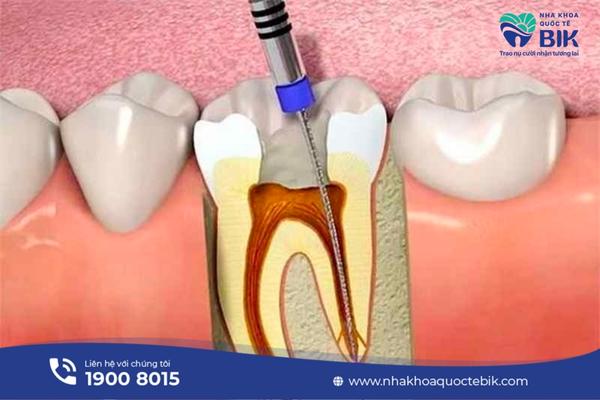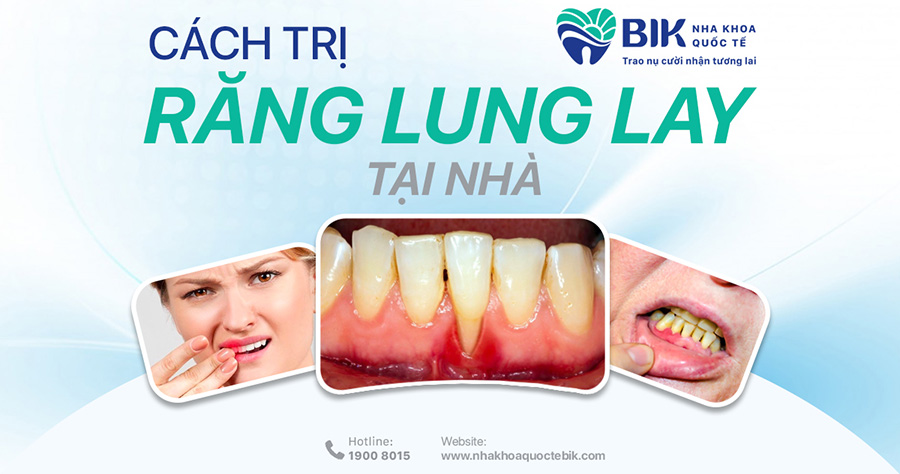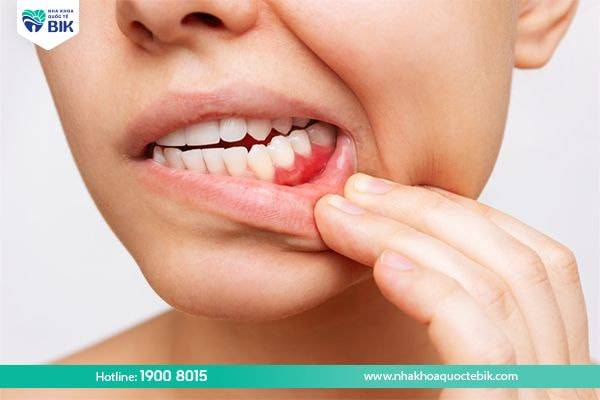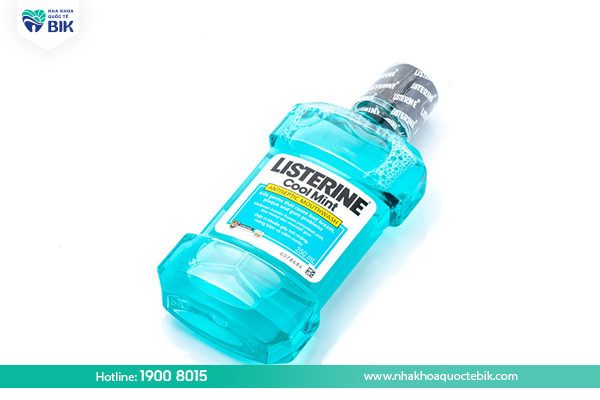Tooth decay is a condition in which holes and tiny black dots appear on the surface of the teeth, which are unsightly and cause prolonged pain that often makes you feel uncomfortable. The cause of tooth decay is believed to be the attack of bacteria formed inside dental plaque. Besides, there are many other factors that cause tooth decay, let’s find out with BIK International Dental Clinic in the article below!
1. Are tooth decay dangerous?
Tooth decay is a condition in which teeth are attacked by bacteria that destroy minerals, causing the hard tissue of the tooth to be lost. Over time, bacteria will attack and create tiny holes in the teeth and then gradually spread. People with tooth decay include everyone, from children to the elderly.
Regardless of age, if tooth decay is not prevented in time, it will cause the following dangerous complications:
– Eating and daily activities are difficult because of tooth sensitivity and frequent pain.
– If the front teeth are decayed, it will affect the overall aesthetics of the face.
– Tooth decay causes bad breath, causing many people to lose confidence when talking to others.
– Severe tooth decay has the potential risk of tooth breakage, tooth chipping and complete tooth loss.
– Tooth decay bacteria attack adjacent teeth if not treated promptly.
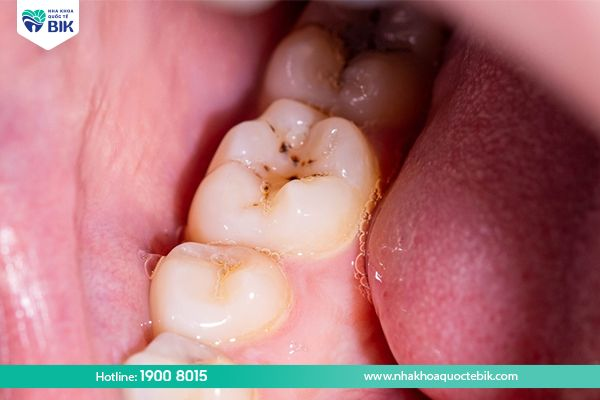
2. Signs of tooth decay
Although tooth decay is a fairly common oral disease, many people often do not recognize the signs of this disease in the early stages. You can refer to some of the following signs of tooth decay:
– The tooth begins to ache continuously or may be intermittent without any impact.
– The tooth becomes more sensitive when eating and drinking, especially with food that is too hot or too cold.
– When observed with the naked eye, holes will appear on the tooth surface.
– Notice obvious black or brown spots. In some severe cases, the breath begins to smell bad.
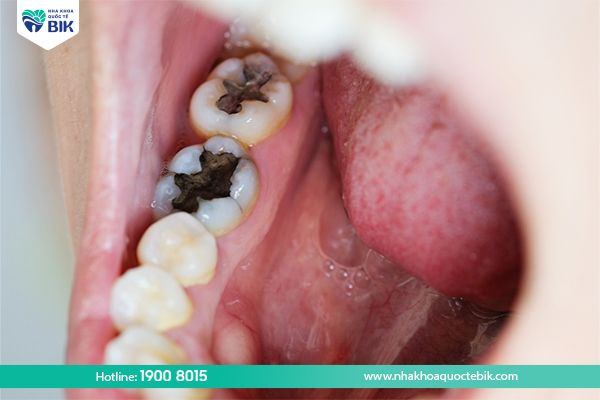
3. What causes tooth decay?
In fact, the cause of tooth decay is the attack of harmful bacteria that cause damage, but you can also refer to the following factors that increase the risk of tooth decay:
– Tooth decay often occurs in molars where there are many small grooves that make food easily stuck, but toothbrushes are often very difficult to clean in this position.
– Regular use of foods such as milk, cream, honey, sugar, carbonated water, cookies, potato chips, … is also the cause of tooth decay because these foods are very easy to stick to the surface of the teeth because they are not washed away by saliva.
– When drinking sugary drinks, it will create a favorable environment for bacteria in the oral cavity to produce acid that attacks and erodes tooth enamel.

– Not brushing teeth properly and thoroughly to remove plaque on the tooth surface.
– Not supplementing enough Fluoride to help prevent tooth decay.
– Older people are at higher risk of tooth decay because their resistance is weaker, but children often have more tooth decay due to eating a lot of candy and cakes.
– Not drinking water regularly leads to dry mouth, creating favorable conditions for bacteria to develop and attack, causing tooth decay.
– Heartburn or gastroesophageal reflux (GERD) can cause stomach acid to flow back into the mouth, eroding tooth enamel and causing significant tooth damage. This exposes the dentin and makes it easier for bacteria to attack and cause tooth decay.
4. Stages of tooth decay
Tooth decay will develop in the following stages:
4.1. Plaque formation
First, plaque will form from foods containing a lot of sugar and starch, but teeth that are not cleaned will often create conditions for bacteria to develop in the oral cavity. Over time, the plaque will calcify into tartar. This layer of tartar is not only hard and difficult to remove, but also a favorable environment for bacteria to grow and develop.
4.2. Damaged tooth enamel
Plaque on teeth contains acid, so it can destroy minerals in tooth enamel. When this layer of tooth enamel is damaged, it will cause holes in the tooth enamel. In terms of stages, this is the first stage of tooth decay. If not treated promptly, bacteria will attack the dentin, causing the first pain for the patient.
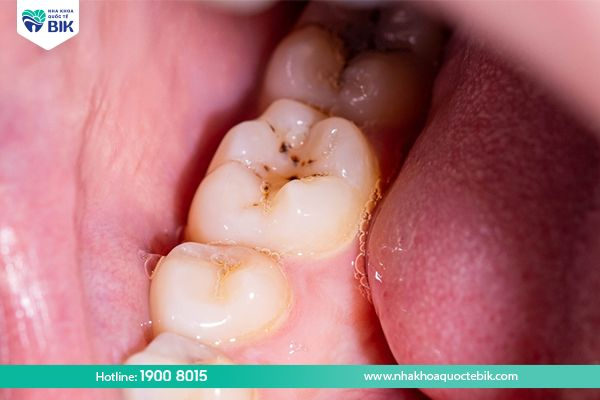
4.3. Bacteria attack the pulp
The condition will become more severe when the bacteria begin to attack deeper and deeper and can reach the pulp – where many blood vessels and nerves are concentrated. This causes the pulp to swell and cause persistent pain, in some cases the nerves can also be compressed.
5. How to treat tooth decay
Based on each stage of tooth decay, the doctor will prescribe appropriate treatment measures to bring the best results:
5.1. Filling cavities
Filling cavities is indicated when bacteria have only attacked the enamel and have not caused too much damage, the cavities are only as small as a pea. The doctor will treat the cavities and then fill the gaps on the tooth surface with specialized materials.
These materials have been tested to be safe, harmless to the human body and are widely used in dentistry. Among them, Composite is probably the most chosen material because it can bring high aesthetics, while effectively restoring chewing ability.
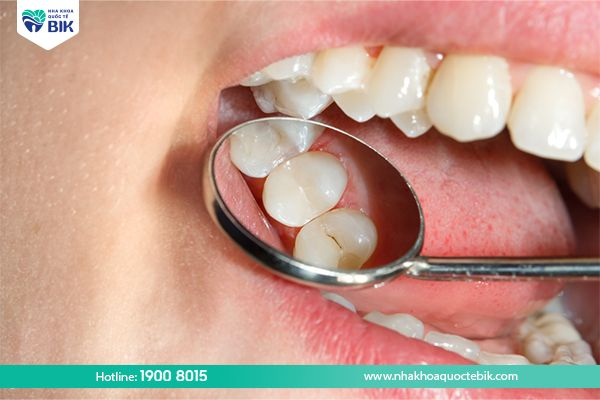
5.2. Porcelain crowns
When bacteria have penetrated deep inside, affecting the tooth pulp, you will have to treat the tooth pulp and then cover it with porcelain crowns. The entire infected pulp will be removed and the space will be filled with specialized materials. After that, the doctor will grind the tooth stump to create a space to attach the porcelain crown on top.
Porcelain crowns not only help restore aesthetics and chewing ability, but also act as a protective layer for real teeth inside from being attacked by tooth decay bacteria again.
5.3. Tooth extraction
The principle when treating oral diseases is to preserve real teeth as much as possible, but if both the dentin and pulp of your tooth have been completely destroyed by tooth decay bacteria, the doctor must prescribe tooth extraction. In this case, keeping the tooth will not have any effect because the tooth cannot survive normally and also increases the risk of other teeth being infected.
After tooth extraction, the patient can have dental implants to restore aesthetics, chewing ability as well as prevent other dangerous complications caused by tooth loss.
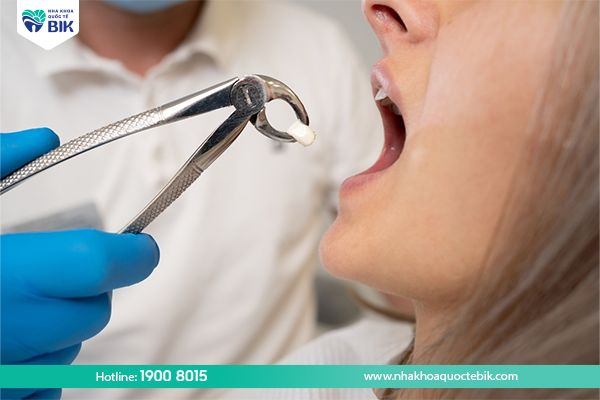
6. Effective measures to prevent tooth decay
To effectively prevent tooth decay, you can refer to the following methods:
– Brush your teeth at least twice a day, at night before going to bed and in the morning after waking up. Use toothpaste containing Fluoride to help keep your teeth strong.
– Use a toothbrush with a small head to clean the inside of the molars.
– Combine the use of dental floss to clean deep between teeth, limit the use of toothpicks because the toothpick head is usually large, so it is easy to cause bleeding gums.
– After snacks, use a mouthwash containing Fluoride to quickly clean the oral cavity.
– Visit and remove tartar periodically at least once every 6 months. Regular dental check-ups will help you easily detect oral diseases early and treat them promptly.
– Limit snacking, especially sweet foods, foods high in sugar such as cakes, candies or carbonated drinks because they will stimulate bacteria to attack tooth enamel.
– Eat foods that are good for teeth, limit the use of foods that are too hard or easily stuck between teeth.
– Use xylitol chewing gum combined with Fluoride to reduce the risk of tooth decay.

There are many causes of tooth decay and if not treated promptly, you may face the most dangerous complication of this disease, which is tooth loss. Therefore, as soon as you detect even the smallest signs of tooth decay, you should be alert and go to a reputable dental facility immediately for examination and necessary treatment.

